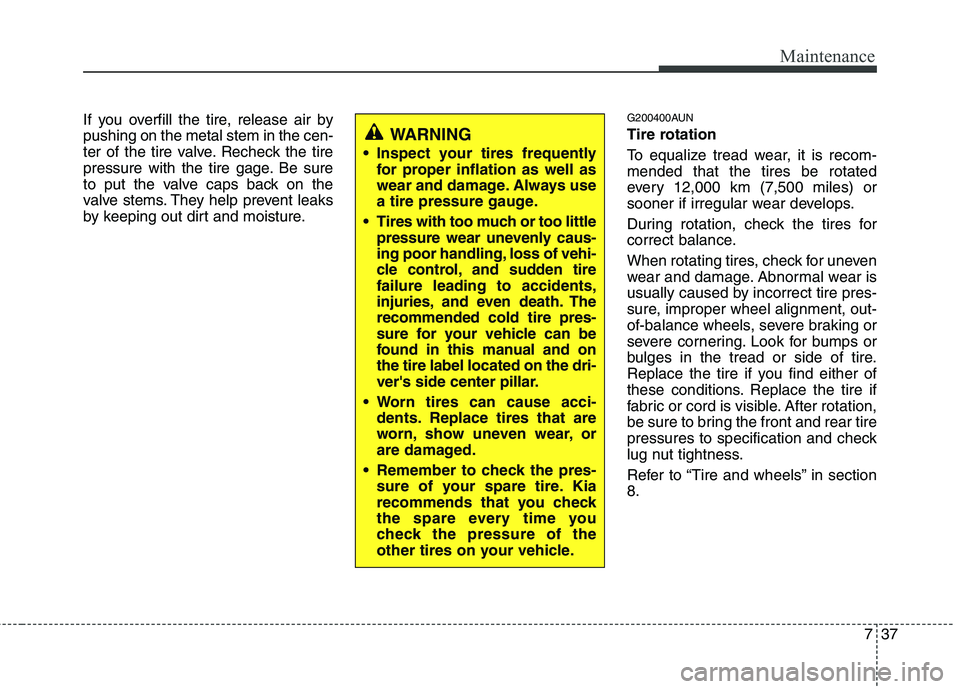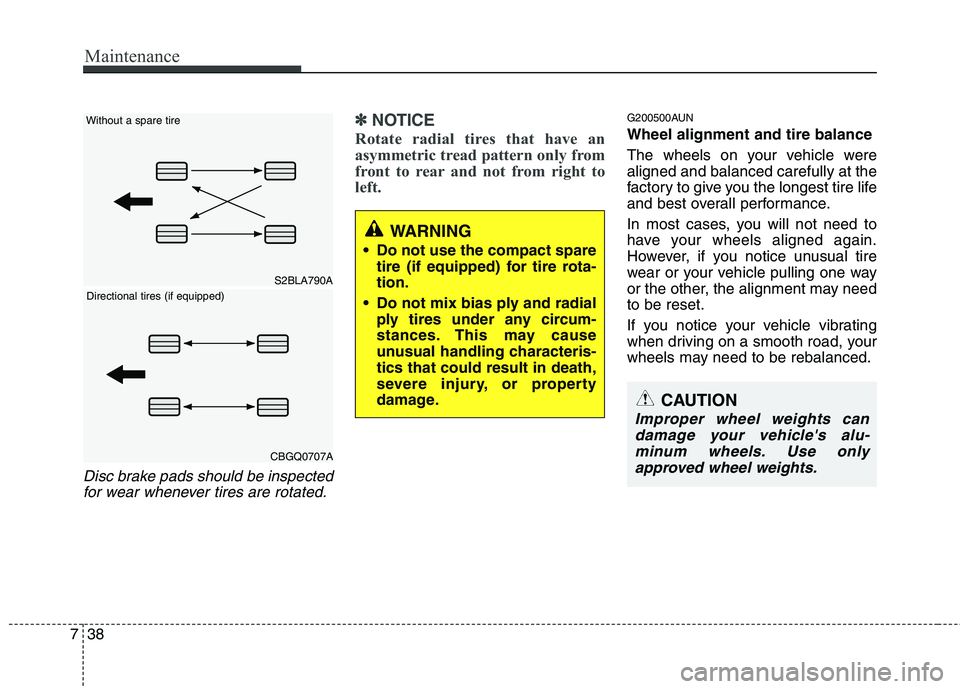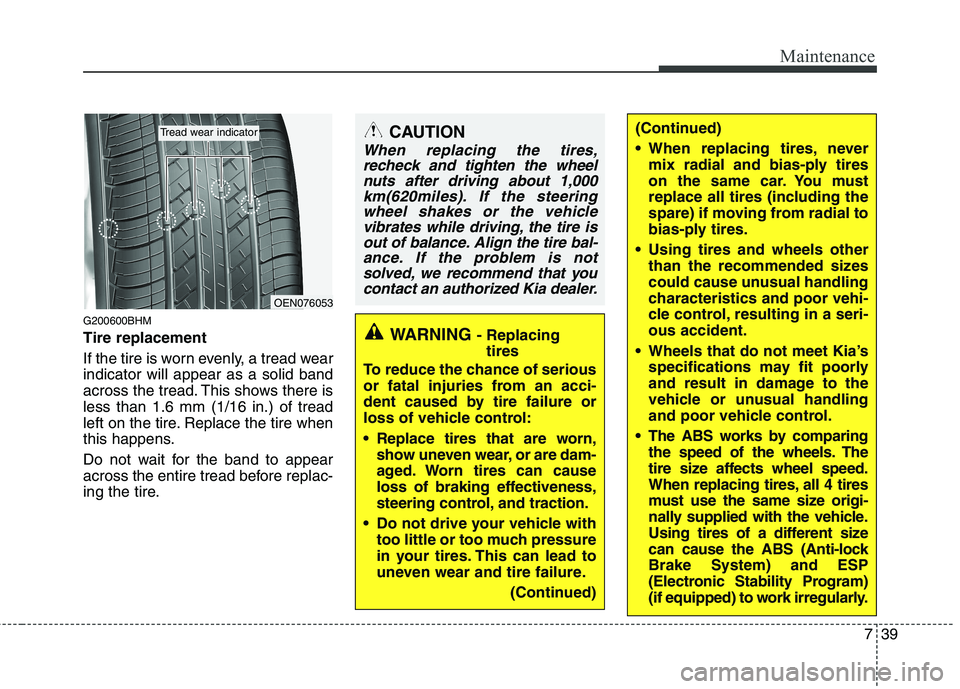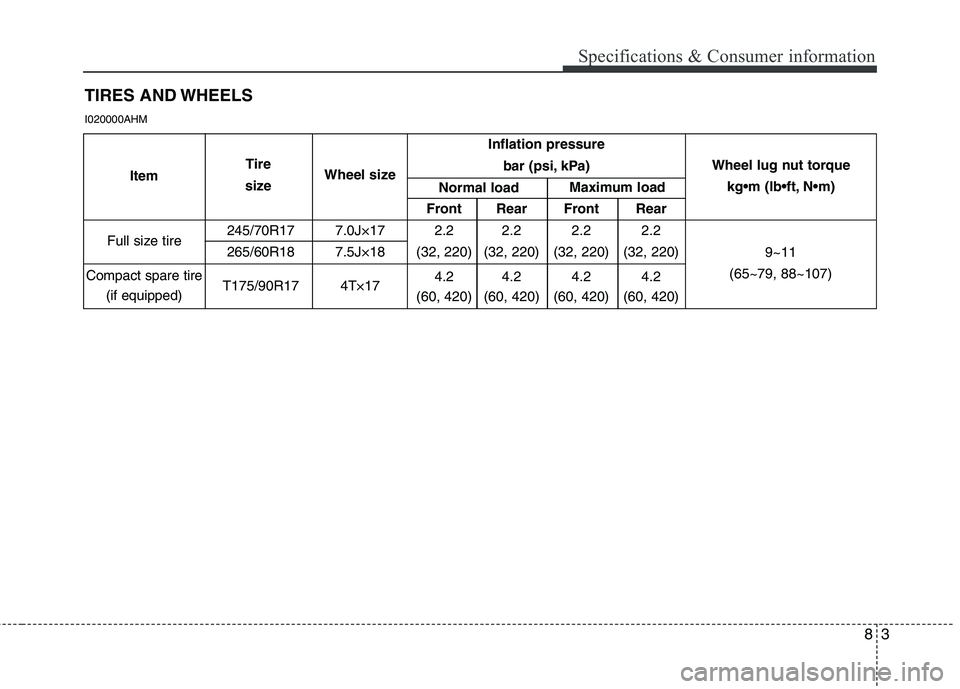2014 KIA MOHAVE spare wheel
[x] Cancel search: spare wheelPage 364 of 417

737
Maintenance
If you overfill the tire, release air by pushing on the metal stem in the cen-
ter of the tire valve. Recheck the tire
pressure with the tire gage. Be sure
to put the valve caps back on the
valve stems. They help prevent leaks
by keeping out dirt and moisture.G200400AUN
Tire rotation
To equalize tread wear, it is recom- mended that the tires be rotated
every 12,000 km (7,500 miles) or
sooner if irregular wear develops.
During rotation, check the tires for
correct balance.
When rotating tires, check for uneven
wear and damage. Abnormal wear is
usually caused by incorrect tire pres-
sure, improper wheel alignment, out-
of-balance wheels, severe braking or
severe cornering. Look for bumps or
bulges in the tread or side of tire.
Replace the tire if you find either of
these conditions. Replace the tire if
fabric or cord is visible. After rotation,
be sure to bring the front and rear tire
pressures to specification and check
lug nut tightness.
Refer to “Tire and wheels” in section 8.
WARNING
Inspect your tires frequently for proper inflation as well as
wear and damage. Always use
a tire pressure gauge.
Tires with too much or too little pressure wear unevenly caus-
ing poor handling, loss of vehi-
cle control, and sudden tirefailure leading to accidents,
injuries, and even death. Therecommended cold tire pres-
sure for your vehicle can be
found in this manual and onthe tire label located on the dri-
ver's side center pillar.
Worn tires can cause acci- dents. Replace tires that are
worn, show uneven wear, or
are damaged.
Remember to check the pres- sure of your spare tire. Kia
recommends that you check
the spare every time you
check the pressure of the
other tires on your vehicle.
Page 365 of 417

Maintenance
38
7
Disc brake pads should be inspected
for wear whenever tires are rotated.
✽✽ NOTICE
Rotate radial tires that have an
asymmetric tread pattern only from
front to rear and not from right to
left.G200500AUN Wheel alignment and tire balance
The wheels on your vehicle were aligned and balanced carefully at the
factory to give you the longest tire life
and best overall performance.
In most cases, you will not need to
have your wheels aligned again.
However, if you notice unusual tire
wear or your vehicle pulling one way
or the other, the alignment may needto be reset.
If you notice your vehicle vibrating
when driving on a smooth road, your
wheels may need to be rebalanced.
WARNING
Do not use the compact spare tire (if equipped) for tire rota- tion.
Do not mix bias ply and radial ply tires under any circum-
stances. This may cause
unusual handling characteris-tics that could result in death,
severe injury, or property
damage.
CAUTION
Improper wheel weights can
damage your vehicle's alu-minum wheels. Use onlyapproved wheel weights.
S2BLA790A
CBGQ0707A
Without a spare tire
Directional tires (if equipped)
Page 366 of 417

739
Maintenance
G200600BHM Tire replacement
If the tire is worn evenly, a tread wear indicator will appear as a solid band
across the tread. This shows there isless than 1.6 mm (1/16 in.) of tread
left on the tire. Replace the tire when
this happens.
Do not wait for the band to appear
across the entire tread before replac-
ing the tire.
OEN076053
Tread wear indicator
WARNING - Replacing
tires
To reduce the chance of serious
or fatal injuries from an acci-
dent caused by tire failure or
loss of vehicle control:
Replace tires that are worn, show uneven wear, or are dam-
aged. Worn tires can cause
loss of braking effectiveness,
steering control, and traction.
Do not drive your vehicle with too little or too much pressure
in your tires. This can lead to
uneven wear and tire failure.
(Continued)
(Continued)
When replacing tires, nevermix radial and bias-ply tires
on the same car. You must
replace all tires (including the
spare) if moving from radial to
bias-ply tires.
Using tires and wheels other than the recommended sizes
could cause unusual handling
characteristics and poor vehi-
cle control, resulting in a seri-ous accident.
Wheels that do not meet Kia’s specifications may fit poorly
and result in damage to the
vehicle or unusual handling
and poor vehicle control.
The ABS works by comparing the speed of the wheels. The
tire size affects wheel speed.
When replacing tires, all 4 tires
must use the same size origi-
nally supplied with the vehicle.
Using tires of a different size
can cause the ABS (Anti-lockBrake System) and ESP
(Electronic Stability Program)
(if equipped) to work irregularly.CAUTION
When replacing the tires,recheck and tighten the wheelnuts after driving about 1,000km(620miles). If the steeringwheel shakes or the vehiclevibrates while driving, the tire isout of balance. Align the tire bal-ance. If the problem is notsolved, we recommend that youcontact an authorized Kia dealer.
Page 367 of 417

Maintenance
40
7
G200601AUN
Compact spare tire replacement
(if equipped)
A compact spare tire has a shorter
tread life than a regular size tire.
Replace it when you can see the
tread wear indicator bars on the tire.The replacement compact spare tire
should be the same size and design
tire as the one provided with your
new vehicle and should be mountedon the same compact spare tire
wheel. The compact spare tire is notdesigned to be mounted on a regular
size wheel, and the compact spare
tire wheel is not designed for mount-
ing a regular size tire. G200700AUN Wheel replacement
When replacing the metal wheels for
any reason, make sure the new
wheels are equivalent to the original
factory units in diameter, rim widthand offset.
G200800AHM Tire traction
Tire traction can be reduced if you
drive on worn tires, tires that are
improperly inflated or on slippery
road surfaces. Tires should be
replaced when tread wear indicators
appear. Slow down whenever there
is rain, snow or ice on the road toreduce the possibility of losing con-
trol of the vehicle.
G200900AUN Tire maintenance In addition to proper inflation, correct wheel alignment helps to decrease
tire wear. If you find a tire is worn
unevenly, have your dealer check thewheel alignment.
When you have new tires installed,
make sure they are balanced. This
will increase vehicle ride comfort and
tire life. Additionally, a tire should
always be rebalanced if it is removedfrom the wheel.
WARNING
A wheel that is not the correct
size may adversely affect wheel
and bearing life, braking and
stopping abilities, handling char-
acteristics, ground clearance,
body-to-tire clearance, snow
chain clearance, speedometer
and odometer calibration, head-
light aim and bumper height.
Page 369 of 417

Maintenance
42
7
G201003AHM
3. Checking tire life
(TIN : Tire Identification Number)
Any tires that are over 6 years old,
based on the manufacturing date,(including the spare tire) should be
replaced by new ones. You can find
the manufacturing date on the tire
sidewall (possibly on the inside of the
wheel), displaying the DOT Code.
The DOT Code is a series of num-
bers on a tire consisting of numbers
and English letters. The manufactur-
ing date is designated by the last four
digits (characters) of the DOT code. DOT : XXXX XXXX OOOO
The front part of the DOT means a
plant code number, tire size and
tread pattern and the last four num-
bers indicate week and year manu-
factured.
For example:
DOT XXXX XXXX 1613 represents
that the tire was produced in the 16th
week of 2013.
G1201004AEN
4. Tire ply composition and material
The number of layers or plies of rub-
ber-coated fabric in the tire. Tire
manufacturers also must indicate the
materials in the tire, which include
steel, nylon, polyester, and others.
The letter "R" means radial ply con-
struction; the letter "D" means diago-
nal or bias ply construction; and theletter "B" means belted-bias ply con-
struction.
G201005AUN
5. Maximum permissible inflation
pressure
This number is the greatest amount of air pressure that should be put in
the tire. Do not exceed the maximum
permissible inflation pressure. Refer
to the Tire and Loading Information
label for recommended inflation
pressure.
S 180 km/h (112 mph)
T 190 km/h (118 mph)
H 210 km/h (130 mph) V 240 km/h (149 mph)
Z Above 240 km/h (149 mph)
Maximum Speed
Speed
Rating
Symbol
WARNING - Tire age
Tires degrade over time, even
when they are not being used.
Regardless of the remaining
tread, we recommend that tires
be replaced after approximately
six (6) years of normal service.
Heat caused by hot climates orfrequent high loading conditions
can accelerate the aging
process. Failure to follow this
warning can result in sudden tire
failure, which could lead to a
loss of control and an accident
involving serious injury or death.
Page 401 of 417

83
Specifications & Consumer information
TIRES AND WHEELS
I020000AHM
Inflation pressure bar (psi, kPa)
Front Rear Front Rear
245/70R17 7.0J×17 2.2 2.2 2.2 2.2
265/60R18 7.5J×18 (32, 220) (32, 220) (32, 220) (32, 220)
T175/90R17 4T×17 4.2 4.2 4.2 4.2
(60, 420) (60, 420) (60, 420) (60, 420)
Full size tire Wheel lug nut torque
9~11
(65~79, 88~107)
Item
Tire
size Wheel size
Normal load Maximum load
Compact spare tire (if equipped)
Page 412 of 417

I5
Index
Jack and tools ·····························································6-7
Removing and storing the spare tire ··························6-8
Floor mat anchor(s) ·····················································4-121Fluid Washer fluid ·····························································7-24
Brakes fluid ······························································7-22
Power steering fluid ··················································7-23
Folding the rear seat ······················································3-17
Four wheel drive (4WD) ················································5-18
Front fog light bulb replacement ··························7-55, 7-57Front seat adjustment - manual ········································3-4
Front seat adjustment - power ·······································3-11
Fuel filler lid ··································································4-26
Fuel filter(for diesel) ······················································7-25
Fuel gauge ······································································4-51
Fuel requirements ····························································1-2Fuses ··············································································7-45 Fuse/relay panel description ····································7-49
Main fuse···································································7-48
Memory fuse ·····························································7-47
Gauge Engine temperature gauge ·········································4-50
Fuel gauge ································································4-51
Glassroof, see panorama sunroof····································4-29
Glove box ·····································································4-114 Hazard warning flasher ··················································4-70
Hazardous driving conditions ········································5-50
Headlight bulb replacement ·································7-55, 7-57
Headlight leveling device ··············································4-75
Headlight washer ····························································4-76
Headrest ··································································3-5, 3-14
Heating and air conditioning ·········································4-88High mounted stop light replacement ····························7-60
Highway driving ····························································5-53
Hill-start assist control (HAC) ········································5-36Hood ···············································································4-24Horn ···············································································4-39
How to use this manual ···················································1-2
ISOFIX system ······························································3-39
Immobilizer system ·························································4-4
Indicators and warnings ·················································4-55
Indicator symbols on the instrument cluster ····················1-6
Inside rearview mirror ····················································4-40
Instrument cluster ··························································4-47
Engine temperature gauge ········································4-50
Fuel gauge ································································4-51
Instrument panel illumination ··································4-49Odometer ··································································4-52
G
I
H
Page 416 of 417

I9
Index
Side impact air bag ························································3-50
Side repeater light bulb replacement ·····························7-57
Side step ········································································4-125
Smart key ·········································································4-6
Smooth cornering ···························································5-51
Snow tires ······································································5-54Spare tire
Compact spare tire ···················································6-14
Compact spare tire replacement ·······························7-40
Removing and storing the spare tire ··························6-8
Special driving conditions ·············································5-50 Driving at night ························································5-51
Driving in flooded areas ···········································5-52
Driving in the rain ····················································5-52
Hazardous driving conditions ··································5-50
Highway driving ·······················································5-53
Rocking the vehicle ··················································5-50
Smooth cornering ·····················································5-51
Speedometer ···································································4-49
Sports mode ···································································5-14
Starting difficulties, see engine will not start ··················6-3
Starting the engine ···························································5-8
Steering wheel ·······························································4-37 Heated steering wheel ···············································4-38Horn ··········································································4-39
Power steering ··························································4-37
Tilt steering ······························································4-37
Steering wheel audio control ·······································4-127 Storage compartment ···················································4-113
Center console storage ···········································4-113
Cool box ··································································4-113
Glove box ·······························································4-114
Luggage box ····························································4-115
Multi box ·································································4-115
Sunglass holder ······················································4-114
Sunroof, see panorama sunroof ·····································4-29
Sunvisor ·······································································4-118
Tachometer ·····································································4-50
Tailgate ···········································································4-18 Emergency tailgate safety release ····························4-19
Tether anchor system ·····················································3-37
Theft-alarm system ························································4-12
Tie-down hook ·······························································6-19
Tilt steering ····································································4-37
Tire specification and pressure label ·······························8-8
Tires and wheels ·····················································7-35, 8-3 Checking tire inflation pressure ·······························7-36
Compact spare tire replacement ·······························7-40
Recommended cold tire inflation pressures ·············7-35
Tire care ···································································7-35
Tire maintenance ······················································7-40
Tire replacement ·······················································7-39
Tire rotation ······························································7-37
T